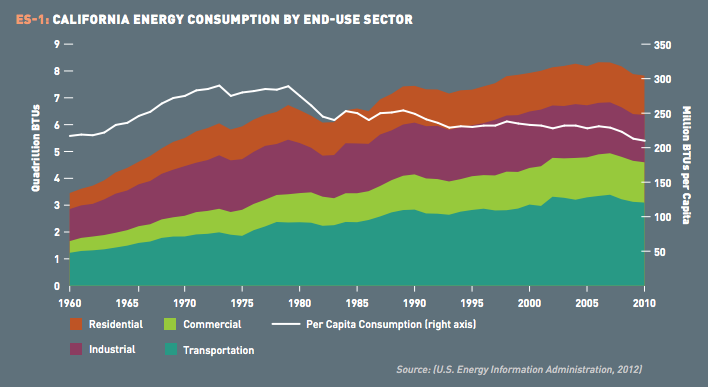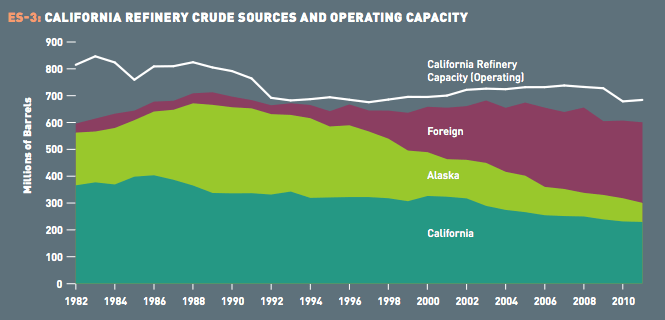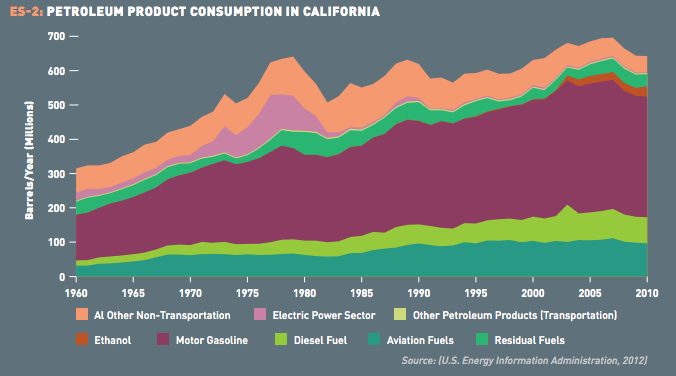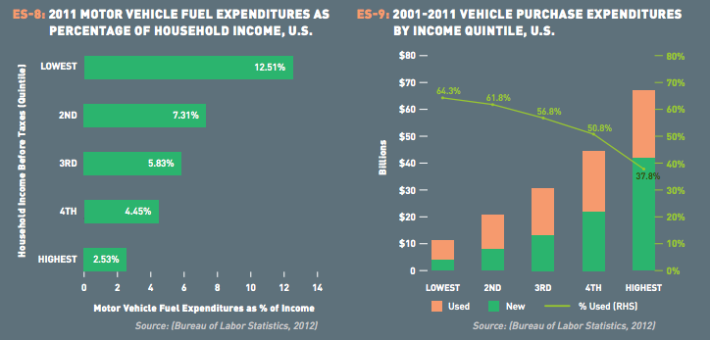The government is encouraging you to drive a car, and if California is truly serious about reducing its oil dependency that needs to change. This is the unequivocal conclusion of Unraveling Ties to Petroleum a new report commissioned by Next 10 California and written by UCLA researchers Juan Matute, Director of the UCLA Local Climate Initiative, and Stephanie Pincetl, Adjunct Professor and Director of the California Center for Sustainable Communities at UCLA.
"State and local policies that promote autos over other modes make it hard to drive less, even when someone is determined to do so," writes Matute.
In addition to compiling mountains of statistics about car use, energy use, and gasoline dependence, the authors looked at fifteen policies that change incentives for driving or land use, and evaluated their total effects on statewide petroleum use. Most of the time, the incentives were not transparent. Together, the policy choices made at the state and local level impact statewide petroleum use by as much as 50 percent.
The biggest change governments can make? Change the non-residential parking policy by changing or removing parking minimums, encouraging different land use through zoning and creating a more attractive urban form. The researchers estimate these changes could reduce gasoline demand in the transportation industry by nearly 25% under the best circumstances. Other potential areas for reform include encouraging insurance companies to offer per-mile rates (an estimated 8% drop), an affordable rideshare and taxi program (up to an 18.35% drop) and even allowing jitney and dollar van services to operate (a whopping .1% drop.)
- Minimum parking requirements for commercial buildings means traveling longer distance to the store or dentist’s office, and indirectly paying for parking you didn’t use when you get there.
- Most local governments in California ignore cyclists, pedestrians, and transit passengers when optimizing their transportation system. This means that any penalty imposed non-drivers on is often outside the scope of analysis, but additional delay to drivers is within the scope of analysis.
- Minimum parking requirements and bundling of parking with other housing amenities penalizes low-car or no-car households that move to high quality transit areas in order to drive less. These households must often pay for parking spaces they don’t want (or wouldn’t be willing to pay $200+/month for) as a condition of moving closer to transit..
- Most Californians pay more on an annual insurance plan than they would on a per-mile plan. This is especially true for households that don’t drive much. The hidden effect is that low-driving households subsidize insurance rates for high-driving households.
Government's pro-car development and laws trickle down so that businesses and other organizations tend to treat all of their customers and clients as though they are car dependent.
Matute explains how many businesses, even ones with the best intentions, are supporting car culture.
"When businesses offer free parking it's usually captured in their overhead," he explains. "This means that those who arrive on foot, bicycle, or transit pay for parking they don't want. Though the extra charge may just be a few cents, similar charges for paper bags are very effective in inducing behavioral change in cities that have banned plastic bags."
While California recently passed laws requiring that land use and transportation plans require that they reduce greenhouse gas emissions, some government bodies are interpreting those laws as just a roadblock to continuing the old method of building more and more highways.
However, now many of these miles are carpool lanes.
Matute and Pincett were unimpressed. If governments are serious about building a carpool network, they could act quickly to restripe existing lanes. Instead, they invest billions of dollars into environmentally damaging road widenings that take years to accomplish what could be completed in a weekend.
If building a carpool network were really the goal, that is. Truthfully, California could truly use some help convincing more people to carpool. In Greater Los Angeles, for example, there are both fewer carpool commuters and a lower percentage of commuters carpooling than there were in the 1970's despite billions being spent to build the world's largest network of carpool lanes.
"Over 69% of all passenger vehicle seat miles in California currently go unfilled," Matute states. "Filling just 10% of these seats could reduce statewide petroleum use by 18%. New online-enabled rideshare services like Lyft and Uber could evolve into platforms that help all Californians share rides for many trips."
But the solution the report seems most excited about isn't carpooling or parking fixes, but ridesharing. In part, a fully developed ride share system would not only encourage people to drive only when they need to, but would save families thousands of dollars every year. The report Unraveling details not just the environmental toll car centric policies bring, but also that the poorest families spend one out of every eight dollars in their pre-tax salaries on gasoline.
Saving residents money. Reducing America and California's dependency on foreign and domestic oil. Cleaning the air. It's sometimes hard to imagine that all of these lofty goals can be accomplished with better parking policy, a built out rideshare system, better zoning and just encouraging more groups of people to get into one car instead of two, or three of more.
(Full Disclosure: Juan Matute is the Chair of the Streetsblog L.A. Editorial Board)










